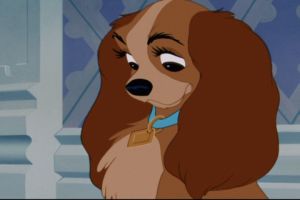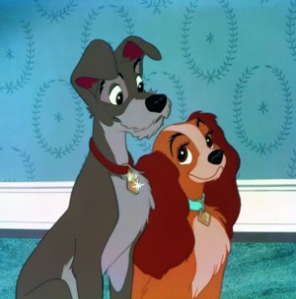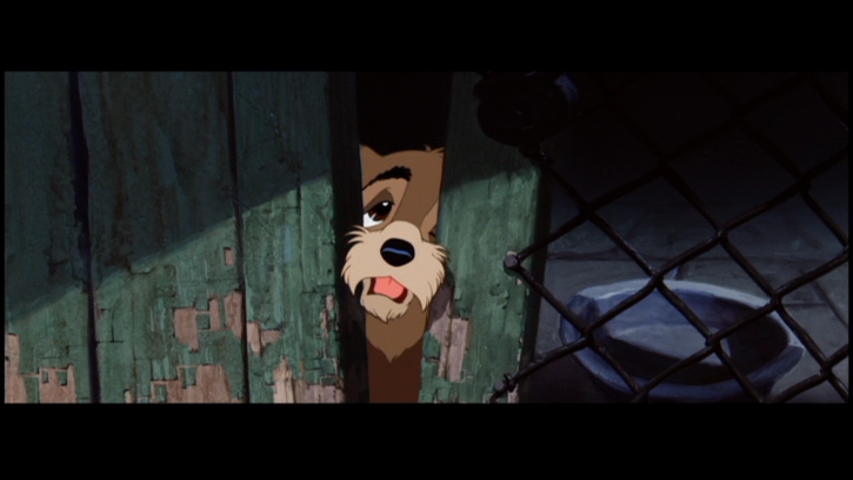First Theatrical Release: June 22, 1955
First Home Viewing Release: October 6, 1987
My Rating: 4/5 stars
Where I Found It: My personal VHS collection — I own the 1998 release.
Bechdel Test Score: Passed. There are a handful of female characters: Lady, Darling, Peg, Aunt Sarah, and (presumably) Si and Am. The first female conversation not related to male characters happens at the baby shower, where Darling is surrounded by women complimenting her appearance. Later, Si and Am discuss how they will terrorize Lady and the baby.
Lady & the Tramp is my favorite Disney movie from the error prior to The Little Mermaid and all that came after it; or perhaps, I should say it is my favorite Disney movie that was made before my own lifetime. Both are true and, unless something changes over the course of this project, that’s still true. My “adult viewing” of Lady & the Tramp last night did not disappoint.
Lady & the Tramp, aside from being a gorgeous work of art from the Victorian mansions to the sparkle in Lady’s eyes, is also a far more “reserved” movie than we’re used to seeing from Disney. There are very few “cartoony” moments, and there are no long comic relief asides such as we see with the Dwarfs in Snow White or the mice in Cinderella. The entire movie is a meticulous study of the lives of two characters from very different worlds, and unlike the romances that came before it, Lady and the Tramp get much closer to equal screentime and character development.
Usually, Disney’s “animal movies” do not rank at the top of my list. But Lady & the Tramp is different, because, well …
It’s Not Really About Dogs
I watched Lady & the Tramp in college and was struck by the realization that it is a movie  about classism. The “licenses” Lady and her friends have entitle them to live in nicer houses and receive better treatment from humans than their unlicensed counterparts. This class tension is particularly noticeable in the scene where the Tramp first visits Lady, and her friends Trusty and Jock immediately bristle. When he shares his negative experiences living in households with babies, they quickly dismiss his experience as “inaccurate.” This despite the fact that there is no evidence either of them have children in their own households — and when Aunt Sarah comes to babysit, Lady does in fact fall victim to the types of slights the Tramp described. But even before that, Jim Dear and Darling had begun to disregard Lady, effectively rendering Jock and Trusty’s placating promises empty.
about classism. The “licenses” Lady and her friends have entitle them to live in nicer houses and receive better treatment from humans than their unlicensed counterparts. This class tension is particularly noticeable in the scene where the Tramp first visits Lady, and her friends Trusty and Jock immediately bristle. When he shares his negative experiences living in households with babies, they quickly dismiss his experience as “inaccurate.” This despite the fact that there is no evidence either of them have children in their own households — and when Aunt Sarah comes to babysit, Lady does in fact fall victim to the types of slights the Tramp described. But even before that, Jim Dear and Darling had begun to disregard Lady, effectively rendering Jock and Trusty’s placating promises empty.
Jock and Trusty similarly give the Tramp the cold shoulder when he comes by to see Lady after she’s busted out of the pound, even though the source of her current misery was only partially related to her adventures on the town with him — one can assume she is still literally “in the doghouse” because of Aunt Sarah’s prejudice against her.
The scenes related to the pound are especially illustrative. My mother, who is a public health nurse, told me once about a workshop she took about the different skill sets people acquire according to their social classes. She was astounded when she saw the list of all the things people in poverty knew how to do that she did not. Two of the items on the list are relevant here: They knew how to get someone out of jail, and they knew how to procure large amounts of cash quickly.
 I couldn’t help but think of that when we see the Tramp bust two of his (also unlicensed) friends out of the dog catcher’s truck. And when he roams the streets deciding from whom he will procure his next meal. He may be license-free, but he’s learned to get by just fine.
I couldn’t help but think of that when we see the Tramp bust two of his (also unlicensed) friends out of the dog catcher’s truck. And when he roams the streets deciding from whom he will procure his next meal. He may be license-free, but he’s learned to get by just fine.
When Lady herself lands in the pound, she receives much better treatment by both the other inmates and the officers than the unlicensed dogs. The other dogs, clearly wise to the ways of incarceration, are nonetheless solicitous and reassuring to Lady. The dogcatcher tells her, “You’re too nice of a girl to be in a place like this.” She is literally perceived as “better” than the dogs around her because she comes from an affluent home, and she is deemed deserving of the special treatment she receives by virtue of this alone.
But the movie isn’t only about class discrimination. It’s also about … monogamy.
How very clever of Disney to use dogs to examine this distinctly uncomfortable topic in family entertainment. If the Tramp were a human character, the movie would be less likely to introduce an ex girlfriend or to imply that he’s had a long string of them. (Off the top of my head, Megara from Hercules is the only Disney protagonist I can think of whose romantic past is referenced in the source movie.) But there is nothing in the movie to indicate that the Tramp isn’t just a serial monogamist when it comes to his “girlfriends,” even if the relationships are especially short-lived. No, the dig at monogamy comes instead in the context of the dogs’ relationships with humans.
Tramp tells Lady he prefers not to be “tied down” and then explains how he has a different family for every day of the week, and a different name as well. He seems to choose his families based on the leftovers they give him, but he speaks of them with what seems to be genuine affection. Tramp’s families seem to be lower-class immigrant families, based on the accents he gives when impersonating them.
At the end of the movie, Tramp has risen to respectability on both counts: he is presumably monogamous (both with Lady and with Jim Dear & Darling), and he is also “licensed” — the symbol that he has risen above his past as surely as Cinderella’s glass slippers represent her ascension up the social hierarchy. Thus, a life of convention is deemed the “right” one, effectively cutting off the provocative questions about class the movie has raised up to this point.
For her part, Lady has had one night out on the town, experienced the thrill of being rowdy, admits that a life without fences “sounds wonderful,” but ultimately feels the pull to return home to “look after the baby.”
That’s why, as much as I love this movie, the ending remains unsatisfying to me. The Tramp has attained something he never aspired to — in fact, he seems to scorn the life lived by the “leash and collar” set. And while Lady may have had her blinders removed for a while, she also seems perfectly content to end the movie more-or-less exactly as she started it. For a story so focused on their character arcs, the ending does neither of them justice.
And ending where Lady runs away with the Tramp would have been equally unsettling, as she clearly adores Jim Dear, Darling, and the new baby. While the Tramp has been accepted into her society, it may only be at the expense of giving up who he really is and distancing himself from his more humble beginnings. Is that a happy ending?
Except When It Is About Dogs
Paradoxically, this movie also works because it seems to get being a dog so right. Despite the large eyes and eyelashes on some characters, the wagging tails and the puppy yips will strike a chord with anyone who has dogs in her life. We even get a glimpse of the sad fate of the many dogs who remain homeless. Today, perhaps even more so than in the Victorian era, euthanasia is the end millions of homeless dogs encounter every year.
Even as its social commentary applies to humans, this movie is also remarkable for its portrayal of a “dog’s-eye-view” of the world. We rarely see human faces but see lots of Victorian boots and skirt bottoms. We never see ceilings but get detailed panoramas of the carpets. And just as we imagine all our dogs do, Lady has an inflated sense of her own role in the family, taking it upon herself to be the one to “look after the baby” even though Jim Dear and Darling would probably do okay without her (don’t tell!)
What Is a Baby, Anyway?
Which brings me to my final observation about the movie, and this one hooks into why I think it was my favorite when I was a child. The sophisticated themes and the implications of the Tramp’s sordid lifestyle went right over my head, but Lady’s distress over the way the baby will change her life did not.
I discovered Lady & the Tramp when I was about 7 years old — two years after the arrival of my own baby sister had turned my family and my life upside down. Today my sister is one of my favorite people in the world, but there is no question that I was incredibly jealous of the amount of time and attention my mother devoted to her, or the way that she had intruded upon an idyllic world of long days of just me and my mom while my older sister was at school.
I never could have articulated it as such at the time, but I think the sting of no longer being the center of Jim Dear and Darling’s lives that Lady felt was what resonated with me as a child. And I doubt I was the only one. Many children go through a similar upheaval when another sibling is born into the family — and this movie offers them a safe outlet for transferring and ultimately making peace with those feelings.
Because the racier elements in this movie will go right over children’s heads while the adorable puppy animation, love story and adjustment to a new baby will not, I would have no reservations about green-lighting this movie for kids — except for that pesky Siamese Cat sequence, which besmirches Lady & the Tramp much in the way “What Makes the Red Man Red?” did Peter Pan. Of all the “further reading” links, I especially urge you to read the one about Si and Am, which includes a video of the sequence if you’ve forgotten how truly offensive it is.
For Further Reading:
- An examination of Si and Am playing to American fears about Asian immigration [As a child, I was strangely captivated by the Siamese cats number, but when I watched it last night, it made my skin crawl with its appalling Asian stereotypes.]
- One father’s diatribe about how Lady & the Tramp sends horrible messages to girls.
- What REALLY happened after that spaghetti dinner?
- A cute recreation of the dinner scene with real dogs.




7 comments